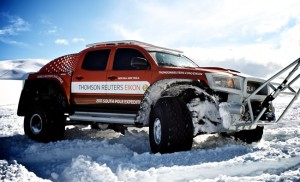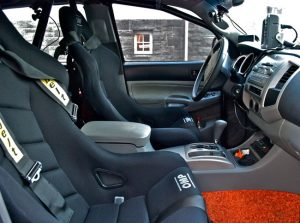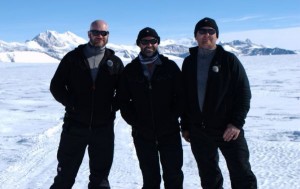1 DAY 15 HOURS 54 MINS!
 After thousands of hours of planning, preparation and hard work the Thomson Reuters Polar Vehicle expedition team smashed the world record for the fastest land crossing to the South Pole on 20 December 2011.
After thousands of hours of planning, preparation and hard work the Thomson Reuters Polar Vehicle expedition team smashed the world record for the fastest land crossing to the South Pole on 20 December 2011.
 On 14 December 2011, exactly 100 years since Amundsen became the first man to reach the South Pole, a three man team (polar explorer Jason De Carteret, Lotus engineer Kieron Bradley and Canadian contest winner Jason Thomas) wanted to break the world record for the fastest overland crossing to the Pole.
On 14 December 2011, exactly 100 years since Amundsen became the first man to reach the South Pole, a three man team (polar explorer Jason De Carteret, Lotus engineer Kieron Bradley and Canadian contest winner Jason Thomas) wanted to break the world record for the fastest overland crossing to the Pole.
Their first official record attempt started at 13.30 GMT on 12 December, but the weather has worked against them. Due to the heavy snowfall the visibility was almost zero, so after checking the weather report and forecast for another couple of hundreds kilometers, the  team came to the conclusion to return to Patriot Hills and wait for the weather to clear up.
team came to the conclusion to return to Patriot Hills and wait for the weather to clear up.
In the camp at Union Glacier the team had to repair both front-end wishbones and their associated parts and they planned the second official attempt for 17 December. Meantime Jason Thomas had to leave the team because of his flight back to Chile and then to Toronto. Finally, one day later on Sunday, 18 December at 20.42 (GMT) the team set off and arrived on 20 December at 12.36 (GMT) to the bottom of the world in record time 39 hours and 54 minutes.
 Sponsored by global information company, Thomson Reuters, the team used a revolutionary new concept vehicle designed by Ian Nisbett Design Ltd (IND) based on Toyota Tacoma. The concept vehicle has been designed with two goals – to break the Antarctic crossing speed record, and also to act as a blueprint and inspiration for a new era in faster, safer and more environmentally friendly polar travel.
Sponsored by global information company, Thomson Reuters, the team used a revolutionary new concept vehicle designed by Ian Nisbett Design Ltd (IND) based on Toyota Tacoma. The concept vehicle has been designed with two goals – to break the Antarctic crossing speed record, and also to act as a blueprint and inspiration for a new era in faster, safer and more environmentally friendly polar travel.
The vehicle features a bioethanol fuelled, 390-horsepower supercharged V6 four-liter engine paired with a five-speed automatic transmission and state of the art solar and wind turbine energy systems. The cabin is crush  proof with both internal and external cages, while integrated crevasse bars and snow anchors are employed against the dangers in Antarctica. Oversized ice specific tires and heavy duty, adjustable suspension maintain speed and agility, while the interior houses live GPS tracking and navigation enhanced with vehicle and safety monitoring systems.
proof with both internal and external cages, while integrated crevasse bars and snow anchors are employed against the dangers in Antarctica. Oversized ice specific tires and heavy duty, adjustable suspension maintain speed and agility, while the interior houses live GPS tracking and navigation enhanced with vehicle and safety monitoring systems.
Related Posts :
Category: NEWS



















